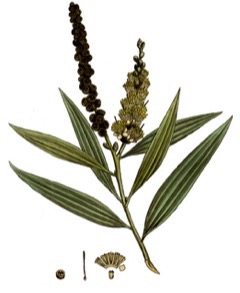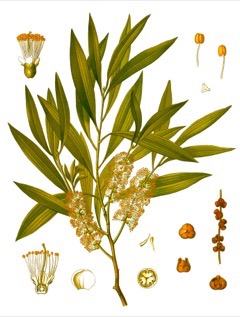 |
|
http://www.edibleplants.org |
 |
| http://www.edibleplants.org |
Translate this page:
Summary
covered with thick and white papery bark and can be up to 150 cm in diameter. It is moderately fast-growing and can survive forest fires. The leaves are alternate, wide, flat, and covered with fine hairs. The flowers are cream or white. The fruit is a woody capsule. Paperbark yields an essential oil used as food flavoring. The essential oil from the leaves has medicinal uses as well. In particular, it relieves spasms and expels internal parasites. It is used for bronchitis, tuberculosis, colds, sinusitis, gastric infections, roundworms, rheumatism, gout, acne, toothache, and skin diseases among others. It is also used in soaps and detergents, perfumery, and insect repellents. The fruits and leaves are used to make tea. The wood is hard and heavy, and ideal for boat or ship building, railway ties, posts, etc.
Physical Characteristics

 Melaleuca leucadendra is an evergreen Tree growing to 30 m (98ft) by 20 m (65ft) at a fast rate.
Melaleuca leucadendra is an evergreen Tree growing to 30 m (98ft) by 20 m (65ft) at a fast rate.
See above for USDA hardiness. It is hardy to UK zone 10 and is frost tender. The flowers are pollinated by Bees, Birds.
It is noted for attracting wildlife.
Suitable for: light (sandy), medium (loamy) and heavy (clay) soils and can grow in nutritionally poor soil. Suitable pH: mildly acid, neutral and basic (mildly alkaline) soils and can grow in saline soils.
It cannot grow in the shade. It prefers moist soil and can tolerate drought. The plant can tolerates strong winds but not maritime exposure.
UK Hardiness Map
US Hardiness Map
Synonyms
Cajuputi leucadendron (L.) A.Lyons Leptospermum leucodendron (L.) J.R.Forst. & G.Forst. Meladendron
Plant Habitats
Edible Uses
Edible Parts: Fruit Leaves Oil
Edible Uses: Oil Tea
The essential oil is used as a flavouring in items such as candy, baked goods, condiments, relishes etc[238 , 301 ]. The fruits and leaves are used to make a tea[301 ].
References More on Edible Uses
Medicinal Uses
Plants For A Future can not take any responsibility for any adverse effects from the use of plants. Always seek advice from a professional before using a plant medicinally.
Antirheumatic Antiseptic Antispasmodic Aromatic Expectorant Odontalgic Parasiticide Stimulant
An essential oil obtained from the leaves contains several terpenoids including 50 - 60% of the strongly antiseptic cineole, betapinene and alpha-terpineol[254 ]. It is aromatic and stimulant with a strong camphoraceous aroma. It is expectorant, relieves spasms, increases perspiration and expels internal parasites[238 ]. It is used internally in the treatment of bronchitis, tuberculosis, colds, sinusitis, gastric infections and roundworms[238 ]. Externally, it is used to treat rheumatism, gout, neuralgia, acne, nasal congestion, sinusitis, toothache, chilblains and skin diseases[238 ]. The leaves and twigs can be harvested at any time of the year and used fresh, dried or the essential oil can be extracted[254 ]. This herb, especially in the form of the essential oil, is subject to legal restrictions in some countries[238 ].
References More on Medicinal Uses
The Bookshop: Edible Plant Books
Our Latest books on Perennial Plants For Food Forests and Permaculture Gardens in paperback or digital formats.

Edible Tropical Plants
Food Forest Plants for Hotter Conditions: 250+ Plants For Tropical Food Forests & Permaculture Gardens.
More

Edible Temperate Plants
Plants for Your Food Forest: 500 Plants for Temperate Food Forests & Permaculture Gardens.
More

More Books
PFAF have eight books available in paperback and digital formats. Browse the shop for more information.
Shop Now
Other Uses
Cosmetic Essential Insecticide Oil Parasiticide Soap Wood
Coastal garden. Public open space. Street tree. Accent. Topiary. Other Uses An essential oil is obtained from the twigs and fresh leaves[46 ]. Called cajeput oil, it has an agreeable camphor-like aroma[46 ]. It is used in detergents, soaps, perfumery and insect repellents[238 ]. The wood is hard, heavy and close-grained[46 ]. Durable in moist soil, it is used for ship building, mine timber, boat building, railway ties, posts etc[46 , 418 ].
Special Uses
Attracts Wildlife
References More on Other Uses
Cultivation details
A plant of the lowland tropics and subtropics, where it is found at elevations up to 800 metres. It grows best in areas where annual daytime temperatures are within the range 28 - 37°c, but can tolerate 18 0- 40°c[418 ]. It prefers a mean annual rainfall in the range 800 - 1,400mm, but tolerates 650 - 1,600mm[418 ]. Prefers a moisture-retentive to wet, neutral to acid soil and a position in full sun[238 ]. Tolerates light and saline soils[238 ]. Prefers a pH in the range 6 - 7, tolerating 5.5 - 8.5[418 ]. Plants are able to withstand periodic inundation of the soil and strong currents. Established plants are drought tolerant[418 ]. Plants are very wind-firm, able to tolerate salt-laden gales[418 ]. On some sites, the plant has the potential of escaping from cultivation and becoming a weed[418 ]. A moderately fast-growing plant[418 ]. Annual wood production potential is 10 - 16 cubic metres per hectare[418 ]. Trees usually survive forest fires[418 ].
References Carbon Farming Information and Carbon Sequestration Information
Temperature Converter
Type a value in the Celsius field to convert the value to Fahrenheit:
Fahrenheit:
The PFAF Bookshop
Plants For A Future have a number of books available in paperback and digital form. Book titles include Edible Plants, Edible Perennials, Edible Trees,Edible Shrubs, Woodland Gardening, and Temperate Food Forest Plants. Our new book is Food Forest Plants For Hotter Conditions (Tropical and Sub-Tropical).
Shop Now
Plant Propagation
Seed (minuscule)
Other Names
If available other names are mentioned here
Paperbark, Weeping Paperbark, Weeping River Teatree, Kayu puteh, Gelam, Med, Samed, Samet, Kayaputi, Cajaputi, Cajuputte, Cajuputa, Cadjeput, Kaiyappudai, cajeput tree, cajepute, cajuput, cajuput (melaleuca leucadendra), cajuput tree|lothsumbulu / weradi lothsumbulu, paper bark tree, river tea tree, weeping tea tree.
Native Range
TROPICAL ASIA: Indonesia (Papua), Papua New Guinea, Indonesia (Maluku) AUSTRALASIA: Australia (Queensland, Western Australia, Northern Territory)
Weed Potential
Right plant wrong place. We are currently updating this section.
Please note that a plant may be invasive in one area but may not in your area so it's worth checking.
Conservation Status
IUCN Red List of Threatened Plants Status : This taxon has not yet been assessed

Growth: S = slow M = medium F = fast. Soil: L = light (sandy) M = medium H = heavy (clay). pH: A = acid N = neutral B = basic (alkaline). Shade: F = full shade S = semi-shade N = no shade. Moisture: D = dry M = Moist We = wet Wa = water.
Now available:
Food Forest Plants for Mediterranean Conditions
350+ Perennial Plants For Mediterranean and Drier Food Forests and Permaculture Gardens.
[Paperback and eBook]
This is the third in Plants For A Future's series of plant guides for food forests tailored to
specific climate zones. Following volumes on temperate and tropical ecosystems, this book focuses
on species suited to Mediterranean conditions—regions with hot, dry summers and cool, wet winters,
often facing the added challenge of climate change.
Read More
Expert comment
Author
(L.) L.
Botanical References
Links / References
For a list of references used on this page please go here
A special thanks to Ken Fern for some of the information used on this page.
Readers comment
| Add a comment |
|
If you have important information about this plant that may help other users please add a comment or link below. Only comments or links that are felt to be directly relevant to a plant will be included. If you think a comment/link or information contained on this page is inaccurate or misleading we would welcome your feedback at [email protected]. If you have questions about a plant please use the Forum on this website as we do not have the resources to answer questions ourselves.
* Please note: the comments by website users are not necessarily those held by PFAF and may give misleading or inaccurate information.
To leave a comment please Register or login here All comments need to be approved so will not appear immediately.
|
Subject : Melaleuca leucadendra
|
|
|
|